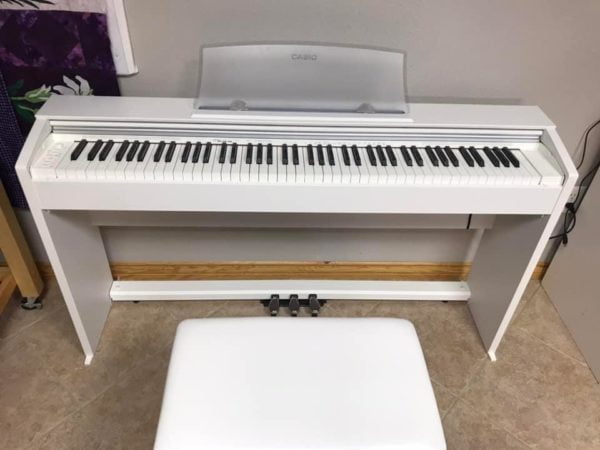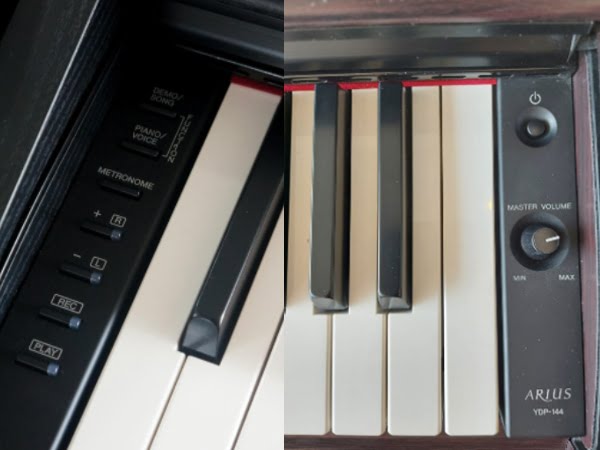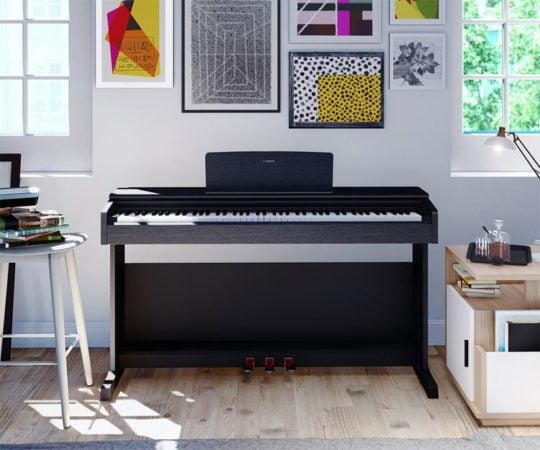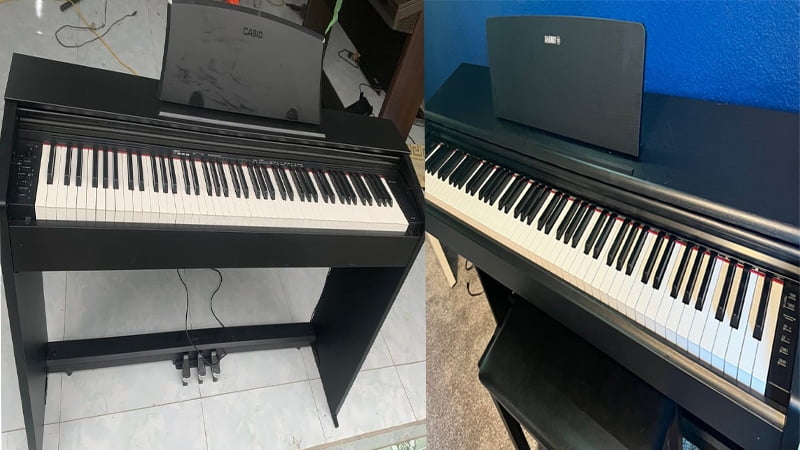Learn which piano is the better investment in this Casio PX-770 vs Yamaha YDP-144 comparison.
When making this Casio PX-770 vs Yamaha YDP-144 comparison, it was easy to assume that the Yamaha model would knock the competition out of the park. On top of being the more expensive model, it’s made by a more prestigious brand. However, as I’ll explain in this article, that wasn’t the case.
To my surprise, I found that the Casio PX-770 was a more worthwhile investment overall. While it shared similar features with the Yamaha YDP-144, it has more built in tones, which is why I declared it the winner.
The Yamaha YDP-144 is a great instrument without a doubt. However, it pales in comparison to the Casio PX-770’s sound library.
So, if you opt for the Casio model, you get more value for a significantly lower price.
Casio PX-770 vs Yamaha YDP-144: Comparison Chart




Last update on 2025-04-17 / Affiliate links / Images from Amazon Product Advertising API
Casio PX-770 vs Yamaha YDP-144: A Head to Head Comparison
Comparing the features of each of these pianos was the best way to find an objective winner. And for the most part, these models were actually tied. However, since the Casio PX-770 has a more versatile sound library, it ultimately won out with a score of 3-2.
Tone
The winner: Casio PX-770
Tone is a very subjective topic, but it’s a great way to distinguish two different digital pianos. And when testing out these pianos for myself, I found that the voices were about equal in terms of quality. However, the Yamaha YDP-144 has a fairly limited sound library, which is why the Casio PX-770 won this category.
+Tone Generation
The Casio PX-770 uses the AiR Sound Source. This is a tone generation system developed by the Casio brand specifically for their premium digital pianos. This system works by playing samples that are triggered whenever a person presses on a key.
However, what sets it apart is AI technology to emulate the way a piano’s sound waves travel through the air. So, the result is a really distinctive and crisp tone that is very similar to a real acoustic piano.
The Yamaha YDP-144, on the other hand, uses the Yamaha CFX Sampling system. This works similarly to the AiR Sound Source. However, the difference is that instead of using AI to emulate an acoustic piano, it plays samples directly recorded from the Yamaha CFX pianos.
In the world of music, the Yamaha CFX pianos are considered some of the best in the business. And since Yamaha used high-quality equipment to record these samples, the result is a tone that’s incredibly similar to the one you’ll hear on the CFX models.

+Sound Library
In terms of tone quality, both pianos were really close together. However, the sound library is what truly sets them apart.
Digital pianos are known for having lesser tones than other digital keyboards. This rings true for both models. However, the Casio PX-770 has more voices than the YDP-144, which makes it the more versatile piano.
The Casio model has 19 built-in voices while the YDP-144 only has 10. With that said, you still get the same voice categories with both options.
Both pianos feature a variety of acoustic and electric piano tones, along with organ, synth, bass, and strings voices. It’s just that the Casio PX-770 features more options in each of these categories compared to the Yamaha YDP-144.
Feel
The winner: Tie
Digital console pianos are designed to emulate the sound and feel of an acoustic piano. To do this, both the Casio PX-770 and the Yamaha YDP-144 feature scaled hammer action and textured keys, which is why they are tied in this category.
+Hammer Action
As mentioned earlier, both models feature scaled hammer action. This is a system wherein the keys on the left side are heavier than the ones on the right side. This is how acoustic piano hammer action works, so you’ll barely notice that you’re playing a digital piano with either the Casio PX-770 or the YDP-144.
With that said each of these pianos achieves scaled hammer action in a different way. While the Casio PX-770 uses the regular scaled hammer action system, the Yamaha features the GHS, or Graded Hammer standard, which is designed to feel the same as their acoustic pianos.
While there are slight differences to the feel of the both pianos, neither offers a more realistic feel than the other. So, regardless of which option you choose, you’re assured that it feels like a regular acoustic piano.
+Key Texture
I was slightly let down to find out the Yamaha YDP-144 used plastic keys. While this is easily forgivable on the more affordable Casio PX-770, I expected more from the premium model.
While plastic keys are usually a bad thing, both pianos took measures to fix the problem. My main issue with plastic keys is that the texture is very different from wooden keys on an acoustic piano.
So, to solve this, both Casio and Yamaha applied a textured coating on the keys. That way, the plastic keys somewhat resemble ebony and ivory in texture.
While this didn’t entirely solve the problem, it did make them feel more realistic. There is still a noticeable difference between the texture on these pianos and an acoustic piano, but it isn’t as glaring compared to non-textured plastic keys.
Piano Features

The winner: Tie
When comparing the piano features of both models, it was a pretty back-and-forth battle. However, in the end, I decided to declare it a tie since both models offer a variety of piano features and effects.
+Playing Modes
The Casio PX-770 features lesson mode. This is designed for piano lessons. With this mode engaged, the keyboard is split into two distinct zones. These zones have the exact same timbre and pitch, so it’s like you have two mini pianos.
So, it’s easier for instructors to demonstrate certain techniques to students without crossing over. Additionally, this also allows teachers and students to play alongside each other as if they were playing on their own separate pianos.
The Yamaha YDP-144, on the other hand, features dual mode. With this mode, you can blend two voices together. This is great for experimentation and adding a personal touch to your tone. For example, if you’re playing the accompaniment for a singer, you can blend the piano and strings voices so it’s like you’re playing with an orchestra.
Another extra mode on both pianos is a recording feature. Both offer two-track recording, but keep in mind that the recording will not be studio-quality. This mode is primarily designed for musicians to record their own playing and listen back on it. From there, they can take notes of areas where they can improve in their playing.
+Polyphony
The Casio PX-770 features 128-note polyphony and the Yamaha YDP-144 features 192 note polyphony. So, the Yamaha YDP-144 will be able to handle more notes at the same time.
The reason this is important is because a high maximum polyphony is necessary when using the dual mode. However, since the Casio PX-770 doesn’t feature this mode,192-note maximum polyphony is unnecessary.
With both pianos, you can easily play dense and spread out chords without worrying about a diminishing sound quality.
+Effects
The Casio PX-770 offered more effects than the Yamaha YDP-144, which came as a surprise to me. The Casio PX-770 offers reverb, chorus, and brilliance effects. While these aren’t as sophisticated as some digital effects modules available, they are decent enough to add a personal touch on your tone.
The Yamaha YDP-144 only features a reverb effect. With that said, this is a very high-quality reverb with 4 different presets, which offers a lot of room for experimentation and personalization.

Casio PX-770 vs Yamaha YDP-144: The Similarities
There aren’t too many similarities between these two pianos. They are made by different brands, are sold at a different price, and are designed for different pianists. With that said, after doing some research, I did find some similarities between the two.
For starters, they’re both console digital pianos with two fairly small speakers. With that said, both pianos offer pretty high-quality speakers that enrich the already nice voices on the instruments.
Additionally, they both feature fully-weighted keyboards. On top of that, the action is scaled, which offers a lot more realism. So, at the end of the day, both pianos are a great investment for any student or musician.
With that said, the Casio PX-770 is the more affordable option, which is why I chose it as the winner.
Quick Rundown of the Casio PX-770
- 88 scaled, weighted hammer-action keys with simulated ebony and ivory textures
- Stunning new piano sound with detailed resonance, plus 18 other Tones
- Stereo speaker system built into stylish, modern wooden cabinet
- Versatile practice, performance, and MIDI recording tools
- 3 year manufacturer extended warranty
Last update on 2025-04-17 / Affiliate links / Images from Amazon Product Advertising API
Quick Rundown of the Yamaha YDP-144
- Your purchase includes One Yamaha Arius Series, YDP144 model | Bench, 50 Classical Music Masterpieces Book, Owner’s manual & Quick Operation Guide
- Piano dimensions – 53-7/16” W x 32-1/16” H x 16-5/8” | Weight – 83 lbs. | Number of pedals – 3 | Max polyphony – 192 | Number of voices – 10 | Headphones – (2) Standard Stereo phone jack | With Recording and Playback capabilities
- GHS weighted action is heavier in the low keys and lighter in the high keys, just like an acoustic piano
- Half-damper pedal control allows for continuously increasing amounts of sustain as the pedal is depressed
- The CFX Premium Grand Piano Voice recreates the power and tone of the flagship CFX concert grand piano from Yamaha
Last update on 2025-04-18 / Affiliate links / Images from Amazon Product Advertising API
Product Videos
Related Articles to Casio Px 770
- Casio PX-770 vs Korg B2SP: A Battle of Budget Console Digital Pianos?
- Casio PX-770 vs Kawai KDP-110: The Best Console Digital Pianos on a Budget?
- Casio PX-770 vs Kawai ES-110: Should You Get A Portable or Console Digital Piano?
- Casio PX-770 vs PX-160: Should You Get A Portable or Console Digital Piano?
- Casio PX-770 vs S1000: Should You Get A Portable or Console Digital Piano?
- Casio PX-770 vs 750: Finding the Best Budget Digital Piano
- Casio PX-770 vs PX-860: Should You Get A Portable or Console Digital Piano?
- Casio PX-770 Vs AP-270: Which Casio Model Wins Out?
- Casio PX-770 Vs 760: Which Is The Better Casio Privia Model?
- Casio PX-770 Vs Yamaha DGX-660: Should You Get A Portable Or Console Digital Piano?
- Casio PX-770 Vs Yamaha YDP-143: Which Is The Better Piano For The Money?
- Casio PX-770 Vs Roland FP-30: Should You Get A Portable or Console Digital Piano?
- Casio PX-770 Vs 780: What’s The Difference Between These Two Digital Pianos?
- Casio PX-770 Vs 870: Which Casio Console Digital Piano Is Better?
- Yamaha P45 vs Casio PX 770: Should You Get the Portable or Console Digital Piano?
- Yamaha P125 vs Casio PX-770 Review: Why the Yamaha P125 Beats Out the Casio Console Digital Piano
Related Articles to Yamaha Ydp 144
- Yamaha YDP144 vs YDP-144R: What’s the Difference?
- Yamaha YDP-144 vs YDP-S54: What’s the Difference?
- Yamaha YDP-144 vs 184: Which Is the Best Arius Model for the Money?
- Yamaha YDP-144 vs YDP-181: Is the YDP-144 a Worthy Upgrade?
- Yamaha YDP-144 vs Roland F-140R: Which Digital Piano Do You Need?
- Yamaha YDP-144 vs Kawai KDP-120: Which Piano Is the Best?
- Yamaha YDP-144 vs Kawai KDP-110: Why the YDP-144 Is the Better Piano
- Yamaha YDP-144 vs 164: Which Is the Better Arius Piano?
- Yamaha DGX-660 vs YDP-144: Which Is the Better Yamaha Piano?
- Yamaha DGX-670 vs YDP 144: Finding the Best Digital Piano
- Yamaha YDP144 vs 163: Which Is The Best Arius?
- Yamaha YDP144 vs S34: Which Suits Your Style Better?
- Yamaha YDP-143 Vs 144: Is The YDP-144 A Worthy Upgrade?
- Yamaha YDP-103 Vs 144: A Battle Of Two Arius Models
- Casio PX-870 Vs Yamaha YDP-144: Which Is The Better Console Digital Piano?
Reference
- Casio PX-770: https://www.sweetwater.com/store/detail/PX770BK–casio-privia-px-770-black-finish
- Yamaha YDP-144: https://usa.yamaha.com/products/musical_instruments/pianos/arius/ydp-144/specs.html
Lulacruza is an electronic folk duo operating at the junction of the hypermodern and the ancient. Our music weaves together hypnotic female singing, South American folk instruments and electronic processing, while channeling pulsating waves from the source of creation.
Lalucruza is also a community where you can connect with other music lovers to collaborate, exchange ideas and share knowledge. A platform for who wants to learns the basics of playing piano, guitar, drum masters’ technique, etc.. is the premise of our website.
